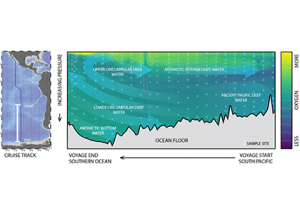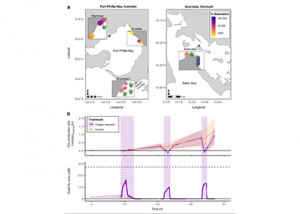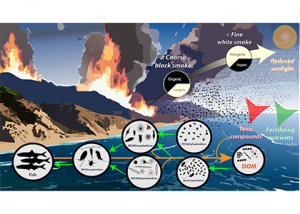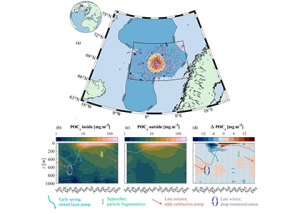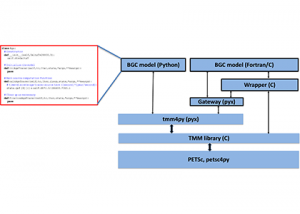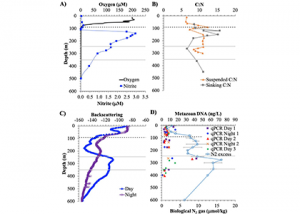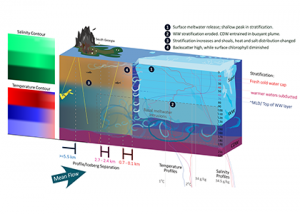If you would like to have your recent publications featured on the OCB website please contact ocb_news@whoi.edu. View our guidelines for writing a New OCB Research post.
A Microbial Conveyor Belt Beneath the South Pacific
Global overturning circulation is a planetary conveyor belt: dense waters sink around Antarctica, spread through the deep ocean for centuries, and eventually rise elsewhere, redistributing heat, nutrients, and carbon. But how does this slow, pervasive movement of water impact marine microbes? To find out, researchers collected over 300 water samples spanning the full depth […]
Read MoreMarine plant metabolites give marine microbes gas
A recent study in Nature Geosciences observed high concentrations of methane overlying permeable (sand) sand sediments in bays in Denmark and Australia. These environments are not one would expect to see methane because they are highly oxygenated and the high concentrations of sulfate in seawater typically inhibit methanogenesis. The authors showed that the methane was […]
Read MoreFrom smoke to sea, how wildfire ash reshapes ocean microbial life
When wildfire smoke drifts over the ocean, what happens beneath the waves? As wildfires change in nature and become more frequent, it’s increasingly important to understand how ash deposition affects the ocean’s smallest, yet most essential, inhabitants. In a recent study, the authors investigated how wildfire ash leachate influences coastal microbial communities. Through field incubations […]
Read MoreHow does a persistent eddy impact the biological carbon pump?
The Lofoten Basin Eddy (LBE) is a unique and persistent anticyclonic feature of the Norwegian Sea that stirs the water column year-round. However, its impact on biogeochemical processes that influence region carbon storage, including carbon fixation, particle aggregation and fragmentation, and remineralization, has remained largely unknown. Using 12 years of data from Biogeochemical-Argo floats and […]
Read MoreNew software enables global ocean biogeochemical modeling in Python
Have you ever wondered what life would be like if you could write and run complex biogeochemical models easily and conveniently in Python? Wonder no more. In a paper published in J. Adv. Model. Earth Syst., Samar Khatiwala (2025; see reference below) describes tmm4py, a new software to enable efficient, global scale biogeochemical modelling in […]
Read MoreDiel Vertically Migrating Zooplankton that spend their day in an Oxygen Deficient Zone to avoid predators are a previously ignored source of organic matter for N2 producing bacteria. A recent study in GBC, examined biogeochemical cycling in the offshore Eastern Tropical North Pacific Oxygen Deficient Zone. They found that the daytime maximum in backscattering, used […]
Read MoreGiant iceberg meltwater supplies nutrients to upper ocean layers
Iceberg meltwater induces mixing which erodes upper-ocean layers. This supplies nutrients, both released from the iceberg and entrained from deeper waters, to surface waters which stimulates phytoplankton growth. Meltwater from the base, sidewalls and surface of giant icebergs influences upper ocean stratification and mixing. Containing a substantial micro-nutrient load, (incorporating nutrient-rich deep waters along with […]
Read MoreThe ocean’s biological carbon pump (BCP) plays a crucial role in regulating Earth’s climate. But how efficiently does it transport carbon to the deep? It has been difficult to answer this question because observations are sparse, labor-intensive, and the uncertainties of the BCP’s magnitude, which are nearly equivalent to human emissions. Fortunately, autonomous vehicles unlock […]
Read MoreNew over-determined CO2 system solver QUODcarb
Do you work with over-determined datasets of seawater carbon dioxide system chemistry? QUODcarb (Quantifying Uncertainty in an Over-Determined marine carbonate system), a new over-determined CO2-system solver is described in the recently published “QUODcarb: A Bayesian solver for over-determined datasets of seawater carbon dioxide system chemistry.” The Bayesian formulation of the novel solver and demonstrates its […]
Read MorePhotoacclimation by phytoplankton under clouds
Unlike most remote sensing products, Net Primary Production (NPP) is computed under clouds. Since satellites can’t see through clouds, NPP models rely on clear-sky observations, interpolate model inputs, and assume that phytoplankton behavior stays the same, regardless of light conditions. But phytoplankton are known to photoacclimate, adjusting their internal chlorophyll to carbon ratio in response […]
Read More
